D–π–A azine based AIEgen with solvent dependent response towards a nerve agent†
Abstract
We developed a D–π–A based unsymmetrical azine molecule 4-((E)-((E)-(4-(dipropylamino)benzylidene)hydrazono)methyl)benzonitrile [DPBN] and studied its optical and aggregation induced emission properties. The DPBN molecule shows good aggregation induced emission (AIE) behaviour with 1157-fold fluorescence enhancement in the aggregated state. In addition to that, both colorimetric as well as fluorometric sensing studies revealed that DPBN selectively detects diethylchlorophosphate (DCP), a potent nerve agent. Interestingly, DPBN shows solvent dependent optical output in the presence of DCP via two different mechanisms. In the monomer state, it shows red shifted fluorescence enhancement along with color change from colorless to orange color via the formation of a new intramolecular charge transfer state in pure tetrahydrofuran (THF). In the aggregated state, DPBN shows blue shifted emission with fluorescence enhancement in THF–water mixture by protonation at the amine nitrogen centre. Thus, DPBN can be used as a diagnostic measure to selectively detect nerve agents like DCP. This study also paves the way for further development of molecular probes for nerve agents that would represent immense implications in various fields of chemistry and biology.



 Please wait while we load your content...
Please wait while we load your content...